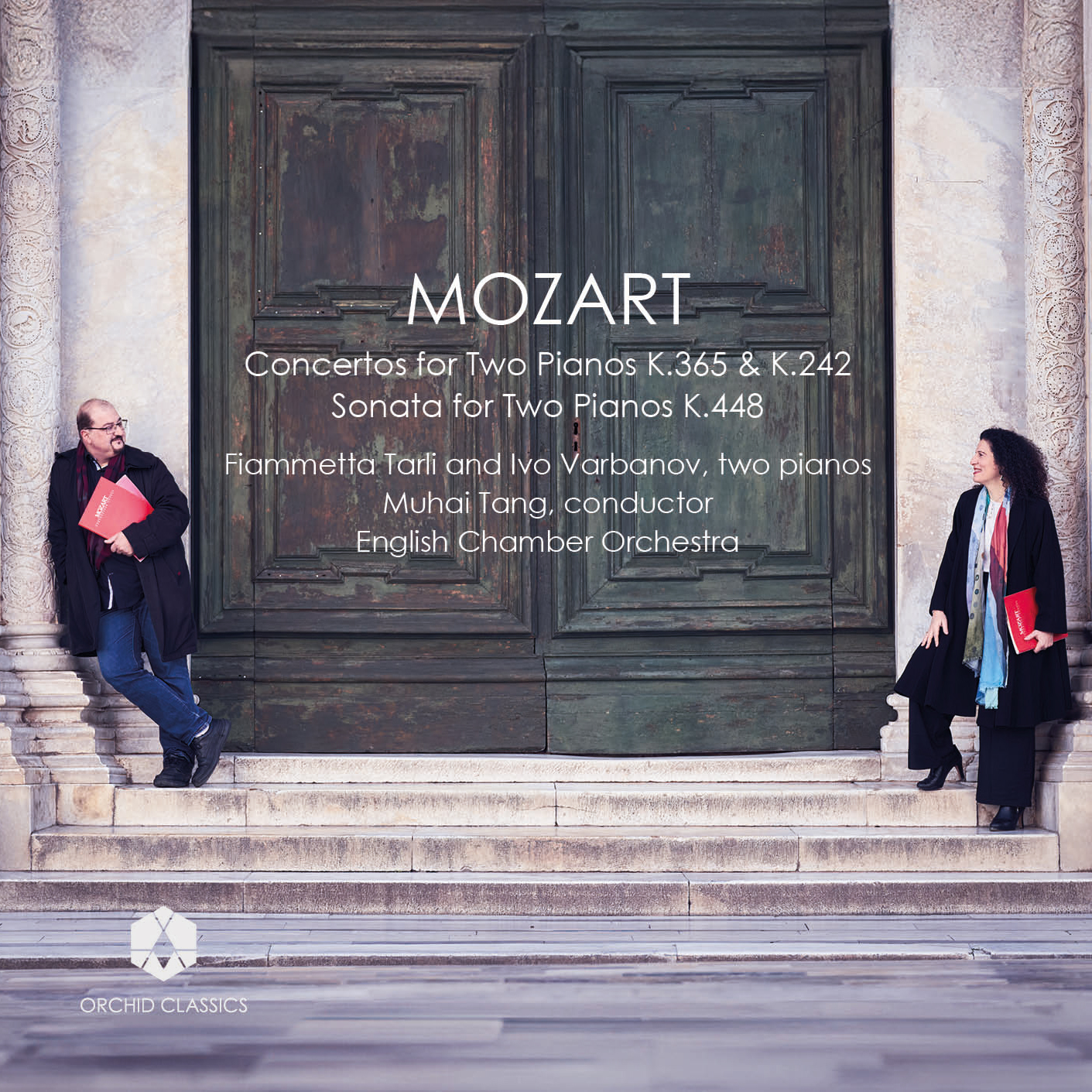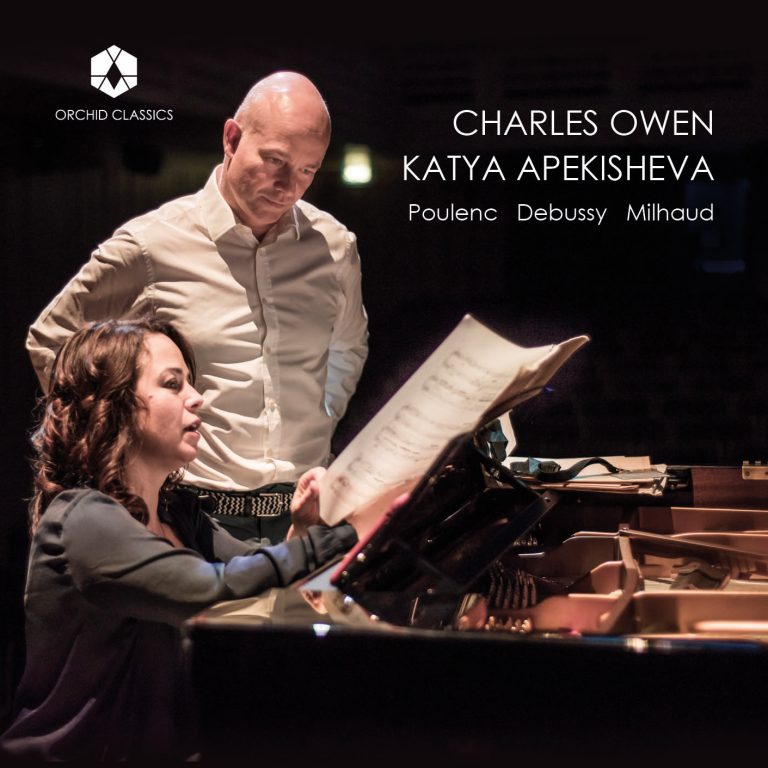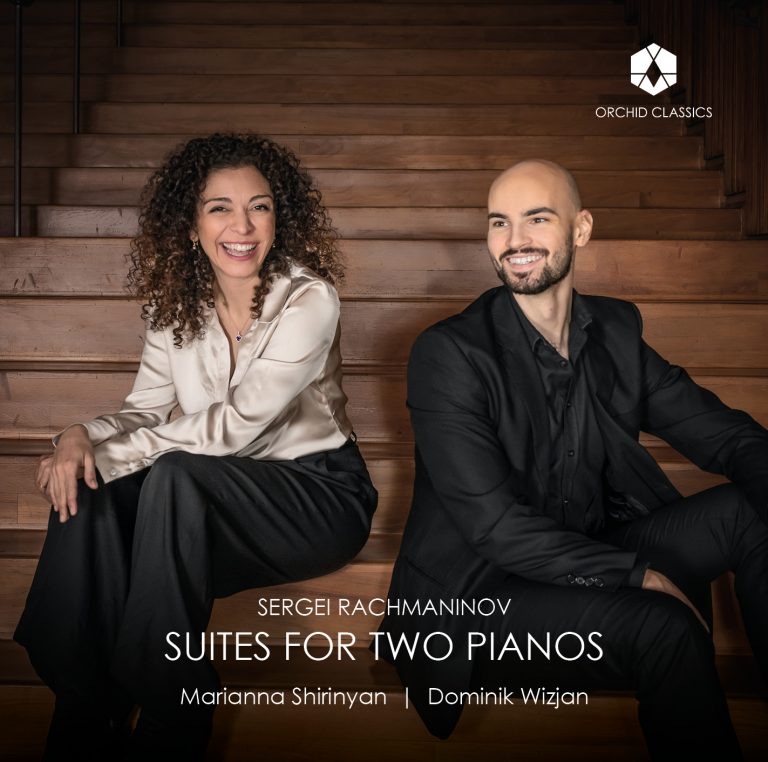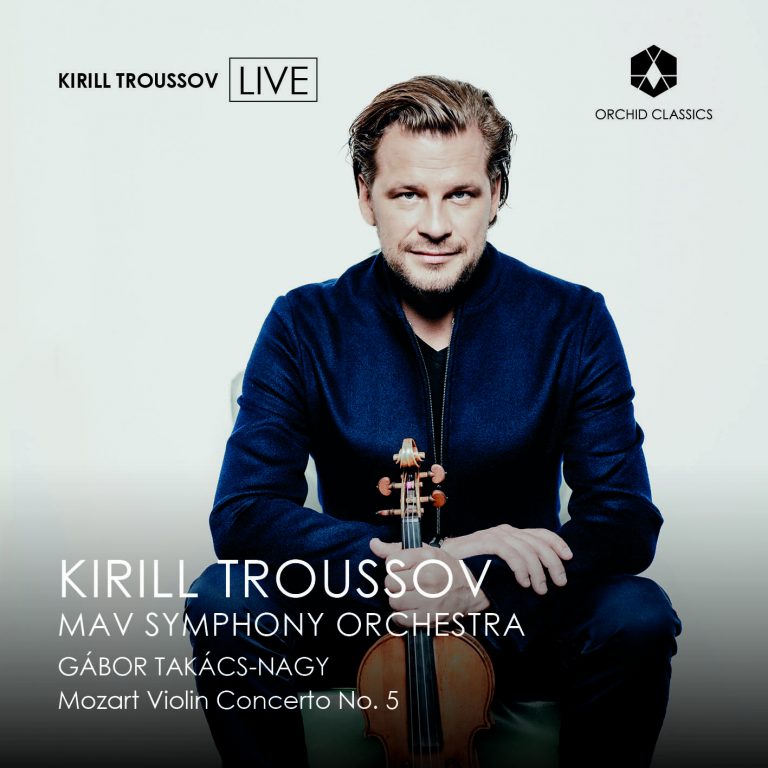Artist Led, Creatively Driven

MOZART
Fiammetta Tarli and Ivo Varbanov, two pianos
Muhai Tang, conductor
English Chamber Orchestra
Release Date: July 26th
ORC100315
Wolfgang Amadeus Mozart (1756-1791)
Concerto for Two Pianos and Orchestra No.10
in E flat major, K.365/316a
1. I Allegro
2. II Andante
3. III Rondeau. Allegro
Concerto for Two Pianos and Orchestra No.7
in F major, K.242
4. I Allegro
5. II Adagio
6. III Rondeau. Tempo di Minuetto
Sonata for Two Pianos in D major, K.448/375a
7. I Allegro con spirito
8. II Andante
9. III Molto Allegro
Fiammetta Tarli, piano
Ivo Varbanov, piano
Muhai Tang, conductor
English Chamber Orchestra
For us, this recording has been a veritable journey.
The concertos K.242 and K.365 and the Sonata K.448 by Mozart are among the first compositions conceived for two keyboard instruments not too dissimilar than our modern pianos. The modern two-piano concept seems almost born with them. Every time we perform them we are astonished by the richness of musical details already present in these pieces: the evenness of the two-piano sound palette allows for a game of subtle dialogues, echo and rhythm effects, whose inventiveness takes our breath away.
Following our belief of recreating the live performance experience through recorded media, we like the natural sound of large recording spaces (here, the Henry Wood Hall in London for the Concertos and Menuhin Hall for the Sonata) in synergy with Tony Faulkner, one of our favourite sound engineers, with whom we have worked on numerous occasions.
We decided to use the Steingräber Phoenix for the Concertos as these magnificent, handcrafted pianos are ideal for performing repertoire requiring extreme finesse with sound nuancing. Apart from their unusual appearance, as they were made in a warm blonde wood colour, the Steingräber Phoenix we played sound very different from the usual bright grandpiano colour. Listeners are going to find that particularly the higher register sounds much more mellow and therefore perhaps a hint closer to how period instruments would have sounded like. For the two-piano concertos by Mozart of this recording the result is striking: thanks to the less aggressive tone, many more details of Mozart’s experimental two-piano writing come to the fore.
Fiammetta Tarli & Ivo Varbanov
By the summer of 1781, Mozart had finally broken free of his employment by the Prince-Archbishop of Salzburg and was living and working in Vienna. The imperial capital provided a host of opportunities to make his name and work alongside other noted brilliant, as well as the chance to enjoy the patronage of a whole range of cultured aristocrats (as well as the Emperor himself) – but he did also need to consider the practical issue of making a living. To that end, and no doubt in part at his father’s urging, he took on several aristocratic pupils who could guarantee a reliable income. And among these first students was the twenty-three-year-old daughter of a court counsellor, named Josepha von Auernhammer.
Since Mozart biographers have tended to draw information about the bit-parts in their famous subject’s life from the composer himself, you’ll find that most writers simply describe Auernhammer as fat and ugly. Mozart’s superbly sensitive assessment to his father reads: ‘If a painter wanted to portray the devil as lifelike as possible, he would have to seek out her face – she is heavy like a peasant wench, sweats to make you sick’… and on and on it goes. A quick reading-between-the-lines of all this malicious filial gossiping, however, reveals a somewhat different picture. Auernhammer was clearly a seriously gifted pianist with ambitions to escape the suffocating world of the Viennese petty aristocracy and build a life as a professional musician in Paris. She confided these hopes to Mozart, whom she evidently adored and admired. But alas her dream did not come to pass, and she was indeed married off to a city clerk just a few years later. She never made it to the French capital – but she did continue to perform, in private and occasionally in public, into the early years of the nineteenth century. She also composed a host of chamber and keyboard works, including variation sets based on melodies by her esteemed tutor.
As for Mozart himself, he seems finally to have realised the musical talent Auernhammer possessed was of rather more profound significance than jokes about her appearance. In November 1781, he composed the Sonata in D major for two pianos K.448 to play together with his accomplished pupil, and they performed it at her family home on 23 November 1781 to an enthusiastic and appreciative audience.
This was not the only two-keyboard work to be performed at the Auernhammer home in November 1781. Mozart also brushed off and revised an earlier piece, a Concerto in E flat major for two pianos K.365 – the first piece on this disc – that he had written for performance with his sister Nannerl in 1779. Nannerl (Maria Anna) Mozart was, like Josepha von Auernhammer, evidently a superbly capable pianist, and as a child she and her brother had performed together in public. But from 1769, when she was 18 years old, her father insisted that she retire from the concert platform as she had reached marriageable age. She continued to perform in private but did not have recourse to the kind of financial and social power (itself relatively limited) of Josepha von Auernhammer that allowed her to go on playing to wider audiences, whilst Auernhammer gave occasional public performances with Mozart until around 1785 and was later widely respected as a pianist and teacher. For the revival of the E flat major Concerto, Mozart expanded the orchestration, adding clarinets, trumpets and timpani, and he and Auernhammer performed the piece in a public concert at the grand Palais Augarten the following year (1782).
The breezy first movement of the E flat Concerto begins – as all Mozart’s concertos do – with an orchestral statement of the principal themes before the entry of the soloists. The formal challenge, then, was to avoid excessive repetition given the present of not one but two soloists. But this is certainly not half as difficult a piece for having double the number of star players! The orchestral writing is very light touch throughout, the pianists effectively accompanying and supporting each other in alternation or strict doubling. A lilting, mellifluous Andante follows this sunny first movement; and the pianists chase each other around the orchestra in the romping Rondo finale, the music eventually bouncing to a cheerful close.
The second piece on this disc is also connected with a group of brilliant female performers. Mozart’s Concerto in F major K.242 started life as a work for three keyboards – pianos or harpsichords – and orchestra, in 1776. It was written at the request of the Countess Antonia von Lodron, an avid musician and patron of the arts in Salzburg, who also had two musical daughters: Maria Aloysia and Maria Josepha. The Countess was acquainted with the entire Mozart family, and in addition to this Concerto Wolfgang also composed a divertimenti for her name-days in both 1776 and 1777.
Within a few years, Mozart reworked this three-keyboard extravaganza for two soloists and performed it with his sister Nannerl in September 1780 – and it is this later version that we hear. It is a noticeably airier, less heavily-scored piece than the E flat Concerto and although it is not without a sense of good humour, it is less explicitly rumbustious than either the later Concerto or the Sonata. This means that the keyboard writing also has a delicacy and charm that was presumably deemed rather more suitable for his aristocratic patrons of the time. Make no mistake, though: behind the graceful contours of its principal themes and its singing central Adagio, Mozart the naughty schoolboy – so willing to assess his young pupils on prettiness alone – is alive and well, from the cheeky trills of the opening Allegro, to each and every jaunty step of the Rondeau finale.
As last piece on this recording, the Sonata in D major K.448 bubbles with good humour and high spirits, with a bouncing first movement and a positively toe-tapping finale surrounding an exquisitely lyrical Andante. Yet for all its bonhomie, it provides its performers with precious few places to hide: the pianists must often execute tricky scales and arpeggios in exact unison, as well as flinging ideas from one player to the other – often at speed. It is a testimony of Auernhammer’s virtuosity that she was not only able to perform such precision manoeuvres as these, but that they were actually written with her specific abilities in mind.
© Katy Hamilton
Fiammetta Tarli & Ivo Varbanov
Two Pianos
When husband and wife Ivo Varbanov and Fiammetta Tarli joined forces and started performing as a piano duo in 2013, a chemistry of musical personalities was immediately evident beyond their bond as husband and wife. Their encounter at the house of Ilona Deckers in Milan, developed ongoing research for the refined central European sound culture.
Fiammetta Tarli started studying piano at the age of five with Giampiero Semeraro in Pisa, her hometown, and gave her first concert at nine. She earned her diploma in Piano Performance and Music Studies at the Florence Conservatoire at the age of seventeen. She specialised in solo repertoire with Maria Tipo, Lydia Rocchetti Pezzati and Ilonka Deckers in Italy, and in chamber music with Iain Ledingham at Royal Academy of Music, London. Her keen interests in literature and musicology prompted her to achieve her Master of Musicology and PhD at King’s College London. Composers Silvina Milstein and Martin Georgiev have composed for Fiammetta as a soloist as well as with Ivo as a piano duo.
Ivo Varbanov started to play the piano at the age of six in his hometown Pleven in Bulgaria with Eleonora Karamisheva. A few years later he studied with Riccardo Bertazzolo and the renowned Hungarian teacher Ilonka Deckers in Italy. After his graduation at the age of twenty, he moved to the UK to work with Sulamita Aronowsky at the Royal Northern College of Music in Manchester and with Frank Wibaut at the Royal Academy of Music in London. Ivo also studied privately with Dennis Lee and has been inspired in masterclasses by such renowned teachers as the pianists Alexander Lonquich, Barry Douglas and Lev Naumov.
To date, Fiammetta Tarli and Ivo Varbanov have made more than twenty commercial recordings as soloists, as piano duo, with orchestra and in various chamber music formations for Hyperion Records, Gega New, B.N.R., Lorelt Records and ICSM Records.
Their solo, chamber music and piano duo performances have been broadcast on BBC Radio, RAI 3, France Music, Radio Toscana Classica, Bulgarian National Radio, Classic FM+, Canadian Radios, US Classical Radios, Spanish National Radio, Slovak National Radio, Bulgarian National TV, BTV and TV Bulgaria.
They have performed as soloists with some of the world’s finest orchestras. These include the Royal Philharmonic Orchestra, Royal Scottish National Orchestra, English Chamber Orchestra, Turku Philharmonic, Sofia Philharmonic Orchestra, Bulgarian National Symphony Orchestra, Sofia Soloists, St Petersburg State Symphony, Tianjin Symphony Orchestra, Orquestra Filarmônica de Minas Gerais and the Gdansk Philharmonic Orchestra, directed by such distinguished conductors as Leif Segerstam, Emil Tabakov, Muhai Tang, Alexander Kantorov, Stanislav Oushev, Massimiliano Caldi, Robert Bokor, Mikolaj Djadura, Yordan Dafov, Martin Georgiev, and Jacques Cohen.
Their recent chamber music collaborations include concerts with Konstantin Lifschitz (two pianos, four hands), the violinist Ofer Falk, violists Jitka Hosprová and Roger Chase, cellists László Fenyö, Seeli Toivio, Jozef Lupták, Rohan De Saram, David Cohen, and Hillel Zori, the Allegri Quartet, the Martinu Quartet, and the horn player Tanja Nisonen.
They have performed as chamber musicians, piano duo, and soloists in more than thirty countries across three continents. Career highlights include multiple performances in London at the Royal Festival Hall, Wigmore Hall, Kings Place, Cadogan Hall and St John’s Smith Square. Other appearances in the UK include the Royal Concert Hall in Glasgow, the Freeman Concert Hall in Manchester, St George’s, Bristol, and the West Road Concert Hall in Cambridge. Further afield, they have performed at Carnegie Recital Hall in New York, the Bulgaria Concert Hall in Sofia and the Philharmonic Hall in St Petersburg, Varna Opera House, and at festivals such as ‘Brahms Unwrapped’ at the Kings Place (London), Wye Valley Music Festival (United Kingdom), ‘Conciertos Temáticos’ in Santander (Spain), the Sofia Music Weeks (Bulgaria), the International Chamber Music Festival ‘Konvergencie’ in Bratislava, Piano Extravaganza (Sofia), Les concerts du foyer Européen (Luxembourg), Ohrid Summer Festival (Macedonia), Apollonia Festival of Arts (Bulgaria), Cervo Summer Festival (Italy), Chopin Marienbad Festival (Czech Republic), Carniarmonie Festival (Italy), and the Lodz Contemporary Music Festival (Poland).
Muhai Tang
Conductor
Muhai Tang is a world-renowned Chinese conductor who has won both a Grammy and an Echo-Klassik award.
He is now the Laureate Conductor of China National Symphony Orchestra and Artistic Director of Shanghai Philharmonic Orchestra, Tianjin Symphony Orchestra, and Harbin Symphony Orchestra.
Muhai Tang was born in Shanghai. He studied composing and conducting in Shanghai Conservatory of Music between 1973 and 1977. In 1979, he won a scholarship to study at the Munich Musik Hochschule. In 1983, at the invitation of Herbert von Karajan, he conducted the Berlin Philharmonic, starting his career as an international conductor. Besides the Berlin Philharmonic, Tang also conducted a number of orchestras worldwide, such as the London Symphony Orchestra, London Philharmonic, Orchestre de Paris, Gewandhausorchester Leipzig, Staatskapelle Dresden, St Petersburg Philharmonic Orchestra, and Israel Philharmonic Orchestra.
Thanks to his father’s education, the famous film director Xiaodan Tang, Tang developed a special love towards opera. He has had successful collaborations with some of the world’s greatest opera houses, such as Teatro alla Scala in Milan, Zurich Opera House, Hungarian State Opera House, Frankfurt Opera House and Munich State Opera House. During the period between 2003 and 2008 he served as chief conductor at the Finnish National Opera. During the Milan Expo in 2015, he conducted the new version of Rossini’s opera Othello at the Scala in Milan. He became the first Chinese conductor performing at that opera house in its 237 years’ history.
He has successively served as the artistic director and chief conductor of the Belgian Royal Flemish Philharmonic, Queensland Symphony Orchestra, Lisbon Orchestra Gulbenkian, Zurich Chamber Orchestra, Prague Symphony Orchestra, and Belgrade Philharmonic Orchestra; he has also successively cooperated with more than one hundred symphony orchestras and chamber orchestras as a visiting conductor.
He has conducted Yehudi Menuhin, Isaac Stern, Mstislav Rostropovich, Jean-Pierre Rampal, Pierre Fournier, Martha Argerich, Anne-Sophie Mutter, Itzhak Perlman, and many others.
Muhai Tang has recorded for a number of labels including Deutsche Grammophon and Teldec. Two operas (Le Comte Ory and Othello) sung by Cecilia Bartoli, directed by Maestro Tang, and produced by the Zurich Opera House in 2014 won the Grammy Award in 2004 and have been published by Decca.
He has directed the premieres of Debussy’s Pelleas and Melisande, Britten’s The Turn of The Screw and the Rape of Lucretia in China. In recent years, he also premiered some Chinese national original operas written by Guan Xia and some other Chinese composers, such as Cai Wenji, A River of Spring Water, A Dream of Red Chamber, Marco Polo, etc.
English Chamber Orchestra
The English Chamber Orchestra has been performing across the UK and globally for over 60 years and is the most recorded chamber orchestra in the world. From its beginning, the ECO has worked consistently with the most significant musical figures in classical music starting in 1960 with its first patron Benjamin Britten. The ECO celebrates and builds upon its tradition of maintaining the highest international musical standards, nurturing new talent and focusing on the ‘best of British’ music and musicianship.
The orchestra has toured the UK and abroad with artists such as Benjamin Britten, Daniel Barenboim, Dame Janet Baker, Colin Davis, Placido Domingo, Jacqueline du Pre, Kiri te Kanawa, Yehudi Menuhin, Luciano Pavarotti, Murray Perahia, Itzhak Perlman, Andre Previn, Karl Richter, Mstislav Rostropovich, Georg Solti, Mitsuko Uchida, Maxim Vengerov and Pinchas Zukerman.
Recent tours have included Bermuda, USA, Mexico, Finland, France, Turkey, Switzerland, Italy, Germany, Slovenia and Austria, as well as concerts across the UK and at London’s Royal Festival Hall, Queen Elizabeth Hall, Kings Place and Cadogan Hall.
HRH The former Prince of Wales has been the Patron of the ECO since 1977 and the orchestra has performed at royal weddings, birthday celebrations and other events including the first concert ever to be broadcast from Buckingham Palace. The orchestra has also recorded many successful film soundtracks including Dario Marianelli’s prizewinning scores for Atonement and Pride and Prejudice.









